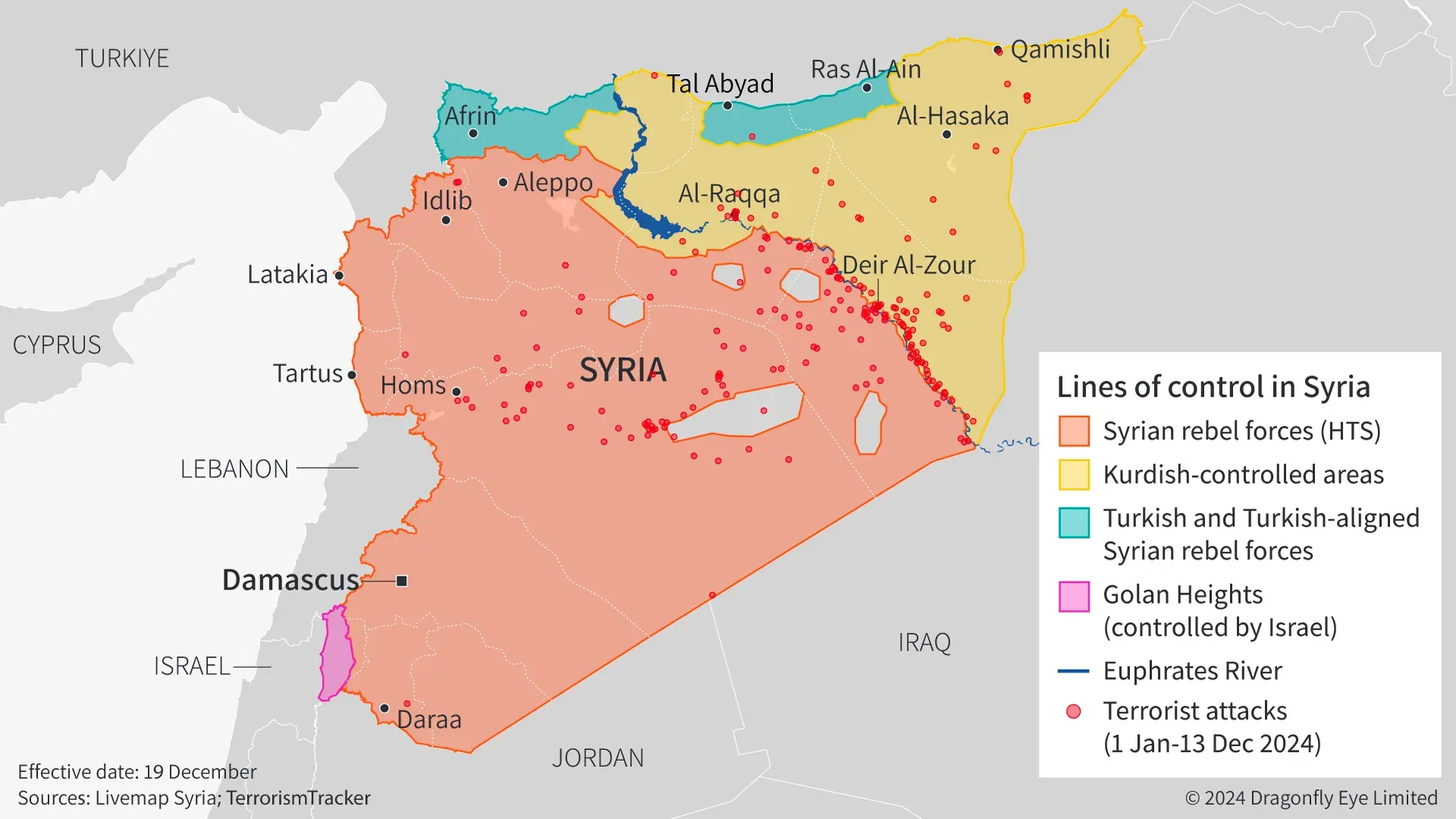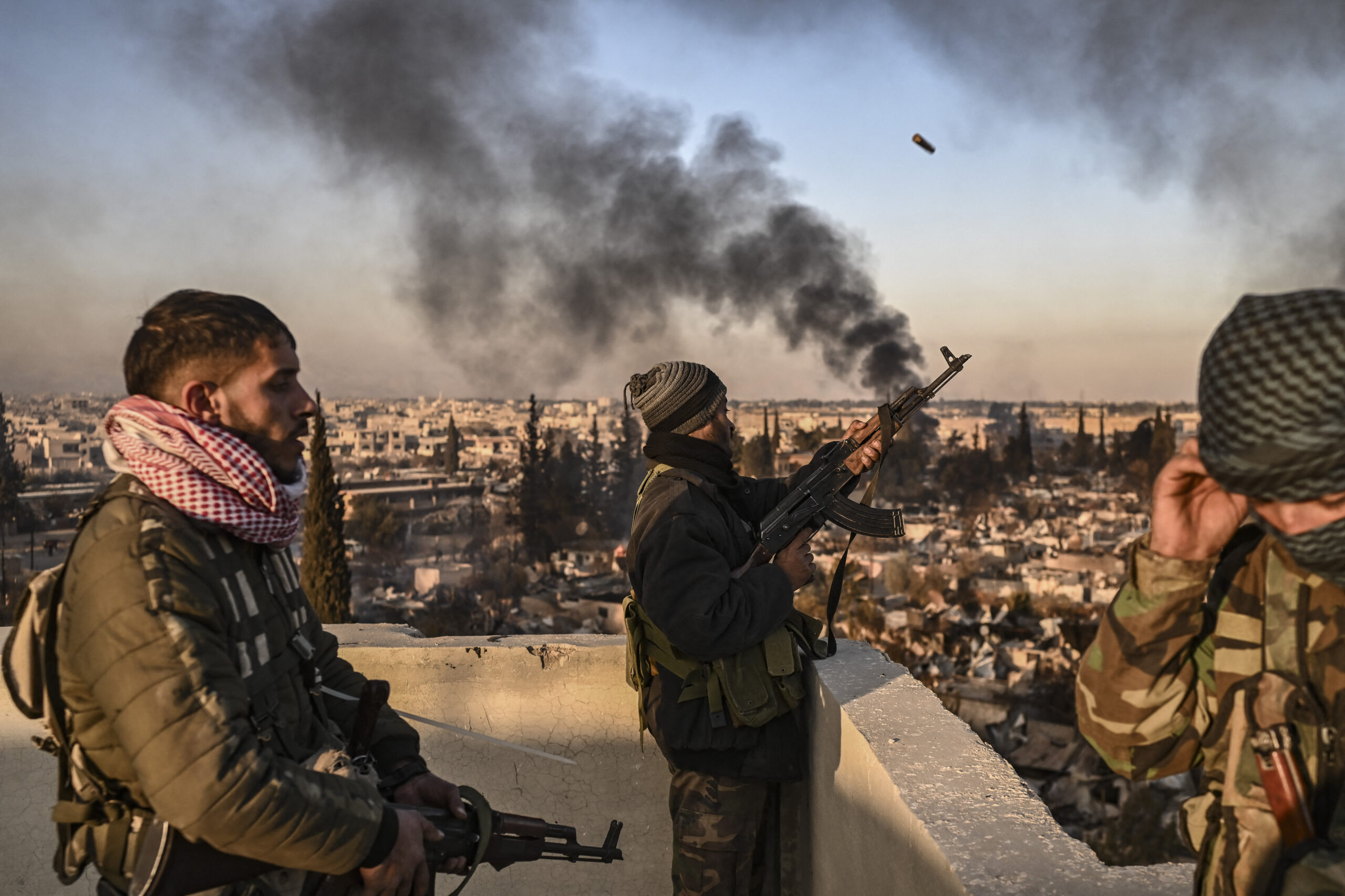The US has warned that the fall of the Assad regime on 8 December could embolden IS and has said it will continue counterterrorism operations in the east of Syria, including by backing Kurdish forces
This assessment was issued to clients of Dragonfly’s Security Intelligence & Analysis Service (SIAS) on 19 December 2024.
- A resurgence of Islamic State (IS) in Syria that involves it capturing territory does not appear imminent, in our assessment
- IS will probably have greater freedom to operate across Syria next year, including in major cities like Damascus
Clients have asked us whether Islamic State will again be able to capture territory in Syria over the coming months. There is currently little to suggest it will do anytime soon. The US has said it will continue to support Kurdish counterterrorism operations there. And IS capabilities appear to have significantly diminished in recent years; the group mounts near-daily attacks, but these have at most been hit-and-run ambushes against Kurdish and former regime forces in villages along the Euphrates River and the central desert. Nonetheless, we anticipate the group will be able to recruit more members and mount more of these kinds of attacks in 2025.
Muted IS reaction to Assad ouster
Official IS channels have been ambivalent to the fall of the Assad regime. IS’s weekly global publication, for example, condemned the takeover of Damascus by Hayat Tahrir Al-Sham (HTS) and the Turkish-backed Syrian National Army (SNA). The group described it as an ‘un-Islamic’ and ‘nationalist’ project. But did not say that it was preparing for a renewed push in Syria. IS supporters meanwhile, have expressed general optimism about the fall of Assad, with many users on the extremist channels we monitor suggesting that a security vacuum in Syria would make the group better positioned to mobilise in central and eastern Syria.

IS is largely an insurgent force in Syria, with most of its attacks being shootings. Robust counterterrorism operations by Kurdish groups in the past few years have made it difficult for the group to establish permanent bases and acquire heavy weapons or build explosive devices. Many IS fighters reportedly live along the Euphrates River. But the group has also expanded its network of smuggling and banditry in central Syria in the past year, offering work opportunities for local men. Signalling this, IS attacks in central Syria this year have been less frequent but far deadlier (at least 800 killed) than those in Kurdish-controlled areas (around 100).
IS is very active on both sides of the Euphrates River, at least in terms of attacks. This is where most of the over 270 fatal IS attacks occurred this year. This is consistent with the same period in 2023. In areas where the Kurdish forces are in control, they have been its primary target (mostly in small villages). In the remote desert areas until very recently held by former regime forces and allied militias, they were its main target. However, most attacks in the past two years have involved shooting ambushes and the use of grenades. Only on seven occasions this year (and six in 2023) did IS fighters use heavier weapons, such as RPGs
Fall of Assad offers opportunities for IS
The fall of the Assad regime will probably make it easier for IS to mount attacks elsewhere in Syria next year. The unfolding dynamics in Syria suggest that IS will have greater freedom. The priority for HTS seems to be consolidating its political power rather than mounting counter-insurgency operations. And Turkish military operations against Kurdish groups in the northeast have already prompted the latter to divert resources away from countering IS. Desertions by former regime forces in central and southern Syria will also present an opportunity for IS to expand its operations. That would include – at the very least attempting – to mount attacks in major cities.
There is also a high chance that fighters from HTS and the SNA will defect to IS. HTS split from IS and Al-Qaeda in 2015. And since it toppled Assad, its leadership has said it is committed to a Syrian republic that will protect minorities. But not all its members share that worldview. Many HTS and Syrian National Army (SNA) rebel fighters have reportedly fought in jihadist insurgencies globally and espouse a radical jihadist ideology. US and Western intelligence estimates that there are several thousand foreign fighters in Syria, many of who defected from IS to HTS and SNA in 2015.
IS unlikely to capture territory over the coming months
There is little to suggest that IS will be able to capture, let alone hold, territory anytime soon. Its tactics suggest diminished capabilities compared with its heyday in 2014, and a focus on insurgency operations. Tens of thousands of its members are in prisons in eastern Syria and Iraq. However, such a resurgence is not implausible. We are monitoring two key developments that, in our view, would enable IS to better group and make a resurgence that involves the group capturing territory likely within a year. These are:
- Kurdish control of northeastern Syria collapses
- The US withdraws its troops from eastern Syria and ends military support for Kurdish counterterrorism operations
Kurdish forces will very probably come under pressure from Turkiye and allied militias in northeast Syria next year. Turkiye seems resolved to use military force to establish a buffer zone along its shared border and confront Kurdish groups it says are linked to the PKK. A sustained confrontation between Kurdish forces and Turkiye carries a high risk of the former losing territory, leaving behind a security vacuum in eastern Syria. It would therefore be highly plausible that IS takes advantage of this to plan mass prison breaks (from facilities currently controlled by Kurdish groups) and seize weapons left behind from any Kurdish withdrawals.
Instability in the east would almost certainly worsen if US forces withdrew from Syria. The US has long supported Kurdish groups through intelligence sharing, training and air support. It has also mounted over 100 air strikes against IS positions since 8 December. The US Department of Defence last week said ‘[we] will not allow ISIS to reconstitute and take advantage of the current situation in Syria’. But President-elect Trump has in the past week said that he wants to end such operations and withdraw US forces from Syria. While such a drawback is plausible, it would probably take several months after Trump assumes office to complete.
Wider regional aspirations constrained for now
Still, we doubt that any IS resurgence in Syria next year would allow it to coordinate with IS in Iraq in the same way it did previously. This is even if the group captured and held territory in Syria. Iraqi counterterrorism operations appear robust, involving near-daily raids and air strikes (supported by the US) against IS positions countrywide. The Iraqi authorities have also bolstered security along the shared border in recent weeks. It is however, plausible that a resurgence of the group in Syria allows it to reestablish the country as a training hub for IS activities globally.
Image: Gunmen stand on the roof of a building to push away looters from the Najha military housing complex in southeast Damascus, Syria, on 17 December 2024. Photo by Aris Messinis/AFP via Getty Images.




